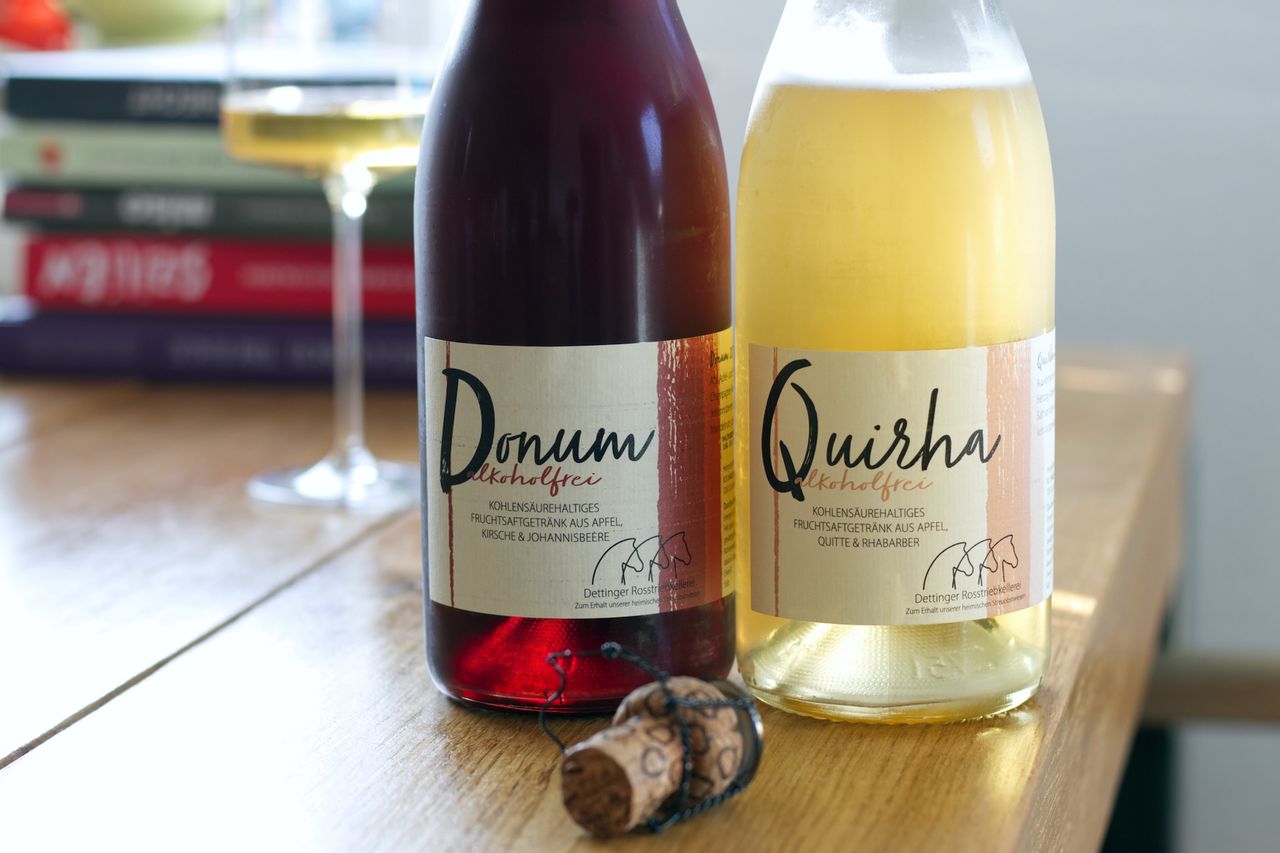Two Bottles Dettinger Rosstriebkellerei
We drink the two non-alcoholic fizzy drinks Quirha and Donum from Dettinger Rosstriebkellerei.

It has become a good tradition for me to use January to discover alcohol-free alternatives. Unfortunately, it seems to become more difficult every year to make exciting new discoveries here. At least throughout the rest of the year, we almost always end up with the same bottles, and due to the lack of vintage variations, it tastes just as good as at the time of writing about it, but it doesn’t make for a new blog contribution. And although, as with PiWis, we try everything alcohol-free at every wine event that comes our way, most products are either boring or too sweet, or boring and too sweet. If the newly discovered item also comes from here, then that’s a little better even. Traditional orchards strongly shape the landscape on the Albtrauf around here and are also important for biodiversity. Because maintaining the meadows is labor-intensive and this effort is not proportionate to the possible yield, many meadows are left to their fate, and you can see that both in the trees and in the fruits. One puzzle piece to counteract this might be producers like the Dettinger Rosstriebkellerei, who pay a price significantly above the usual market price to those who grow old varieties without spraying and harvest them in pure varieties. Timo Dollinger and Valerie Eberle have been running the winery in the Ermstal for a few years now. A beautiful spot of earth, but I am not completely unbiased in this judgment either. Under the label Kulinalb, local products from the Swabian Alb are also sold, and I think that’s a good thing too. The basis for the two alcohol-free sparkling wines Quirha and Donum are precisely these old varieties, Champagne Renette, Boskoop, Gewürzluike, and Co. In addition, there are quince and rhubarb, or for the red one, cherries and currants. Although I am aware that quince and rhubarb can somehow be processed into Quirha, I’m not really excited about the naming. It just does not ring in my ears.
Lost potential in the names, because in the nose, the Quirha is super fresh with a lot of apple. You can sense the quince if you know it’s there. Rhubarb is sought in vain when smelling. In between, there is also something herbal that reminds one of woodruff. In taste, rhubarb and quince are much more noticeable than when smelling. I had already written at the beginning that too much sweetness breaks the neck of many alcohol-free products. This is a ride on the razor’s edge in that regard. The bottle says 8.8 grams of sugar, however, per 100ml and not per liter. This is more than the Sparkling Teas from van Nahmen have, but less than many Priseccos. If it gets a little too warm in the glass, then for my taste, it’s still too much. The quince provides structure, the rhubarb acidity, and the old varieties naturally have a good amount of acidity in them too. It’s already delicious, but it’s really good for a spicy stir fry with lots of vegetables and rice. The fruit really comes through there and it becomes very creamy in mouthfeel. I’d take this over a Kabi on some days.
In Donum, there’s a lot of cherry at first. A lot of cherry. I’m suprised at how much more this dominates the perception, but it’s of course much further away from the apple than a quince is, and much more mass-marketable. Maybe there’s just more of it in there too. The fruit is really nice. Super clear, fresh, a bit candy-like, and behind that, blackcurrant. And here, it drinks exactly as it smells. The acidity has traction, and although the sugar content is only marginally smaller, it initially feels much drier. However, the sweetness is still there, of course. Fruit seccos are rarely, actually never, really complex, but there’s something to discover here too when you put your nose to the glass. Where the white one shone primarily as a substitute for Kabi at meals, I’ll just drink this one empty on its own. And as it disappears from the glass, the cherry recedes and the currant becomes more and more intense. Eventually, the sweetness here also becomes satiating, but until then, it’s really nice. Great fruit juice with bubbles in it.